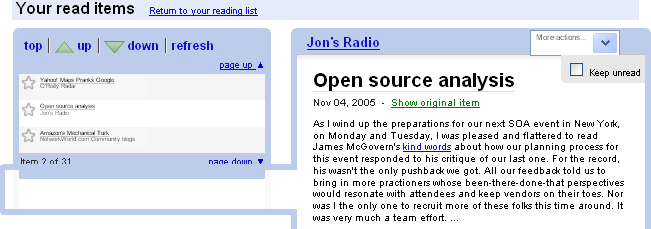

| Here the user has subscribed to four feeds: CIS 471, Jon's Radio, Keith Shaw's Cool Tools, and O'reilly Radar. To subscribe, the user simply pasted the feed URL into the RSS reader. For example, the CIS471 feed is at http://feeds.feedburner.com/cis471. |

|
| The reader displays new postings on these four blogs in chronological order. The user is reading a post called "Open source analysis" from the Jon's Radio blog. On the left, you see other items from other blogs. If the user is interested in more detail, he or she can link to the original posting or to the blog. |
|
There are two types of RSS reader, browser-based and stand-alone. The example shown above is using Google's browser-based feed reader, Google Reader. A browser-based reader can be used from anywhere on the Internet, and the user does not have to worry about software upgrades. Stand-alone feed readers are generally faster and offer more features, but you must have them installed on your computer.
Each reader has different features. Google Reader, shown here, allows you to add and drop subscriptions, see posts from individual blogs or aggregate them, see only unread posts or all posts, tag and star posts for future reference, and share selected posts with others. Note that if you have shared posts, people can subscribe to your shared post feed, and receive an update whenever you share a new post. RSS can be used to notify a person or program of the occurrence of any event.
Here is a short video on RSS and another one on Google Reader. Google also has help on their reader, including this sequence on Getting started and helpful keyboard shortcuts like m: mark as read, n: next item, and p: previous item, enter: toggle extended/list view.
If you are overwhelemed by the number of posts your reader presents, you might want to try filtering out all but the best using a service like Aiderss.com.
There are competing RSS format standards, Atom and RSS, but since readers support both, you do not have to worry about that.
Finally, you can also subscribe to RSS feeds and have new postings sent by email, but you will not enjoy the post and blog management features of an RSS reader.